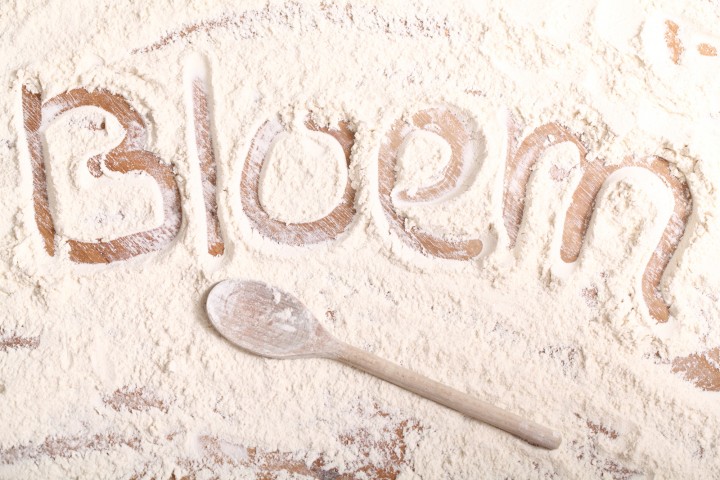
Flour quality and type are the essence of good bread. It all begins with buying the right kind for your recipe!
Getting good quality flour is the easiest way to improve the way your bread will look and taste. Flour from supermarkets tends to be very white, often old, lacking in taste and natural enzymes, and, most important, not very useful for bread baking (at least over here in Holland).
We get our flour from a windmill, which gets its wheat from the center of The Netherlands. They then grind it on big stones, powered by wind. The flour has an EKO (organic) seal of approval, a very nice yellowish hue from the natural carotene and it tastes of fresh grass and wheat berries. The flour is so fresh we have to ‘store’ it for 2 weeks to improve the baking properties and water absorption ability.
We are very lucky to have found great bread flour so close to home. How much difference it makes is also shown in our flour experiment for which we baked the same loaf with both high quality flour from a mill and cheap supermarket flour.
This flour overview teaches you more about flour types and how they are referred to in different countries. It can help you buy the right type of flour, no matter what country you bake in.
| Ash | Protein | US | German | French | Italian | Netherlands |
|---|---|---|---|---|---|---|
| ~ 0.4% | ~ 9% | pastry flour | 405 | 45 | 00 | zeeuwse bloem |
| ~ 0.55% | ~ 11% | all-purpose flour | 550 | 55 | 0 | patentbloem |
| ~ 0.8% | ~ 14% | high gluten flour | 812 | 80 | 1 | tarwebloem |
| ~ 1% | ~ 15% | first clear flour | 1050 | 110 | 2 | gebuilde bloem |
| > 1.5% | ~ 13% | whole wheat flour | 1700 | 150 | Farina integrale | volkorenmeel |
Ash content explained
To establish the ash content of flour a fixed amount of the flour is burned and what is left after this process is the ‘ash’. The amount that is left is expressed as a percentage of the original fixed amount. The ash consist of minerals that are left after burning, so they do not combust.
It is a way of determining the quality / purity of the flour. A higher ash content indicates that the flour contains more of the germ, bran, and outer endosperm. Lower ash content indicates that the flour is more refined. As you can see in the table above, the whole wheat flour has the highest ash content.
German flour type numbers (Mehltypen) indicate the amount of ash (unburned mineral content, measured in milligrams) obtained from 100 g of the dry mass of this flour. Standard wheat flours range from type 405 for normal white wheat flour for baking, to strong bread flour types 550, 812, and the darker types 1050 and 1700 for wholegrain breads. There is also a type 1600 which fits between white wheat flour and whole wheat flour, it will give you a darker white bread.
French flour type numbers indicate the ash content (in milligrams) per 10 g flour. The numbers are a factor 10 lower than the German types. Type 55 is the standard, hard-wheat white flour for baking, including puff pastries (“pâte feuilletée”). Type 45 is often called pastry flour, and is generally from a softer wheat (this corresponds to what older French texts call “farine de gruau”). Some recipes use Type 45 for croissants although many French bakers use Type 55 or a combination of Types 45 and 55. Types 65, 80, and 110 are strong bread flours of increasing darkness, and type 150 is a wholemeal flour. Note that there is no type 40 French flour like the German type 405, the closest is type 45.
In the United States and the United Kingdom, no numbered standardized flour types are defined, and the ash mass is only rarely given on the label by flour manufacturers. However, the legally required standard nutrition label specifies the protein content of the flour, which is also a way for comparing the extraction rates of different available flour types.
British flour types for bread baking:
Stoneground strong wholemeal* 100% extraction rate* – 12-14% protein
Stoneground wholemeal 95% extraction rate – 12-14% protein
Strong white extraction rate 72-75% – 12 to 13% protein
Extra strong white extraction rate 72-75% – 14 to 15% protein
Plain white 72-75% extraction rate – 9 to 11% protein (can be use to replace Italian 00 flour for example, but less suitable for most bread baking and most often used for cakes and cookies / biscuits)
Brown 80% extraction rate – 12-14% protein
*Extraction rate: The amount of original grain left in the flour. These extraction rates are not often mentioned on the bags. To make white flour you sift out germ and bran. If you sift out all the germ and bran it’s about 28% and you end up with 72% extraction flour.
*We often use the term wholewheat (like in America) but it means the same as the UK term wholemeal, but wholemeal can also refer to other grains like wholemeal spelt flour. In Holland we call this ‘volkoren’.
In the Netherlands it is even harder to establish the protein content and ash mass as most bags simply state ‘Tarwebloem’ or ‘Patentbloem’. As a general rule all flour, both ‘Tarwebloem’ and ‘Patentbloem’, you can buy in supermarkets have a low protein content and will not bake great bread. We have found out, by baking and experimenting a lot, that most ‘Tarwebloem’ flours sold by windmills in The Netherlands work well for baking artisan breads.
Soft wheat with lower protein content and less gluten is used for pastry. Hard wheat with higher protein content and more gluten is used for bread.
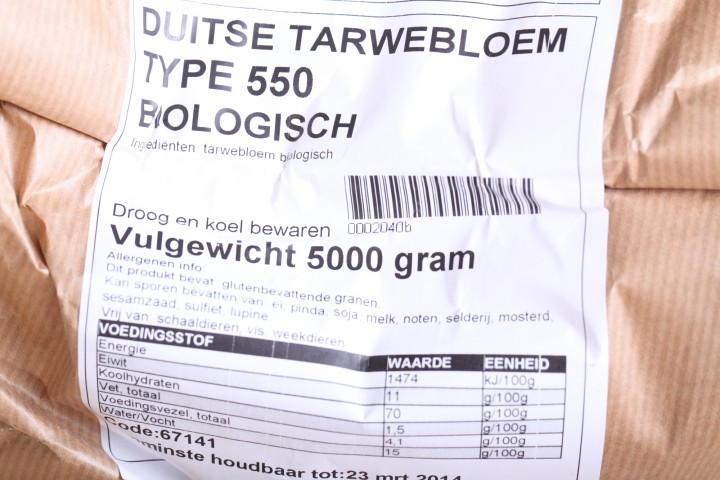
In general, as the extraction rate of the flour increases, so do both the protein and the ash content. However, as the extraction rate approaches 100% (whole meal), the protein content drops slightly, while the ash content continues to rise. Apart from the extraction rate itself the wheat can be of the soft or hard type. Hard wheat (usually hard spring wheat) has a higher gluten content (between 11% and 13%) and is excellent for baking bread. Soft wheat has a lower gluten content (between 9% and 11%) and is often used in all purpose flour and pastry flour which gives a more crumbly texture. Soft flour is usually divided into cake flour, which is the lowest in gluten, and pastry flour, which has slightly more gluten than cake flour. To make things even more complex, you can make whole wheat flour from soft wheat and patent flour from hard wheat and vice versa.
The English word for “flour” is originally a variant of the word “flower”. Both derive from the Old French fleur or flour, which had the literal meaning “blossom,” and a figurative meaning “the finest.” The phrase “fleur de farine” meant “the finest part of the meal,” since flour resulted from the elimination of coarse and unwanted matter from the grain during milling.
‘Dutch’ flour glossary
| Flour | Description |
|---|---|
| 00 bloem | Very fine Italian flour made of hard- or soft wheat. |
| Amerikaanse patent | A high protein content wheat flour, so very high in gluten. Found in Dutch bakeries under the name ‘lely’. |
| Bread flour | Usually to indicate a high protein content wheat flour (around 13%), so very high in gluten. |
| Durum | Triticum Durum, a wheat type with high protein content growing in warm areas. The germ has a yellow hue. Often used for Italian pasta. |
| Franse bloem | Very fine flour of only the germ and the endosperm. Often used for French baguettes. |
| Gebuilde bloem | Fine flour with only a part of the bran (usually has an extraction of 80% and 85%). |
| Grano Tenero | Soft wheat, low in gluten. Available in different extractions. |
| Grano Duro | Hard wheat, high in gluten. Available in different extractions. |
| Griesmeel | Coarse ground grains, for example wheat, spelt, corn or rice. |
| Kiem | Germ, the seed for a new plant, contains B vitamins, some protein, minerals and healthy oils. |
| Manitoba | A Canadian high protein content wheat flour, so very high in gluten. |
| Meellichaam / Meelkern | Endosperm, contains starch, protein, some vitamins and minerals. This is the food source for the germ to grow into a new plant. |
| Patentbloem | Very fine wheat flour without germ and bran. There is a big difference in quality between brands. |
| Patisserie bloem | Zeeuwse bloem or pastry flour. Very finy white flour with a low gluten content. |
| Semolina | Coarse ground grains, often from durum wheat. |
| Semolina rimacinata | Fine ground grains, often from durum wheat. |
| Tarwebloem | Fine ground wheat. Whiteness is between ‘patentbloem’ and ‘tarwemeel’. |
| Tarwemeel | A blend of ½ bread flour, ½ whole wheat, used in ‘tarwebrood’. |
| Volkorenmeel | The coarse ground complete wheat grain, contains the whole kernel, used for ‘volkorenbrood’. |
| Zachte bloem | Triticum Sativum, soft wheat flour with low to medium protein / gluten content. |
| Zeeuwse bloem | Fine flour with low gluten content, used for cookies and pastry. |
| Zemel | Bran, protective outer shell. High in fiber and B vitamins. |



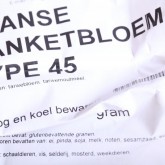
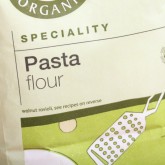
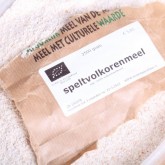
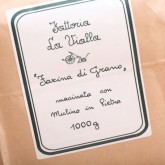
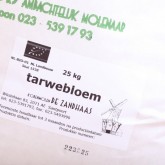
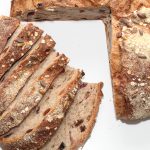

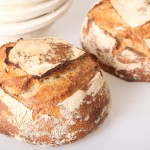
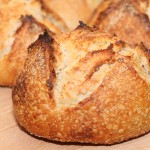
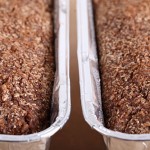

Carolyn Giardini says
Is there a 5 X Flour for baking some one I know heard of this for baking thank you for your reply. Carolyn
Weekend Bakers says
Hello Carolyn,
We do not understand your question or the 5X. Could you maybe rephrase and also tell us what country you are from and what you want to bake?
Laura Etheridge says
Hello,
I’m trying to find out what kind of flour is one called for in Eric Kayser’s Larousse Book of Bread, it’s called “fine wheat flour” and in the recipe is mixed 50:50 with all purpose flour.
I live in the US by the way, thanks in advance for any help.
Weekend Bakers says
Hello Laura,
Without knowing the recipe we think it would be best to ask for this type of flour:
Strong white extraction rate 72-75% – 12 to 13% protein
Enjoy your baking in the US!
T says
So this is a nice article! But I still have questions 🙂
In France, I used to bake with some T80 flour or T110 or even T150. In such flour, you can not feel any particles in the flour.
When baking in the Nederlands with darker kind of flour than Tarwe bloem, for example gebuilde bloem, you can feel and see small (bran?) particles in the flour, and I am not speaking here about Volkoren, which is so coarse it is almost like sand 🙂 I find that these “pieces” really damage the gluten when kneading.
How do you deal with that?
Did you find a mill producing very fine flour with a higher ash content?
Otherwise, how do you knead your douhgt with particles in?
Best,
T
Weekend Bakers says
Hello T,
We think how flour is made and presented is also culturally defined. Visible fibers in flour in Holland also are also perceived as healthy, just like course, dense and dark bread, which you are less likely to encounter in France we think.
But we do not think you should worry about damaging gluten because there is some bran in the flour. The basic flour we use all the time for our bread, the organic tarwebloem, has bran particles in it and that is no problem at all for our baking results. It is the amount of gluten and amount and weight of fibers that play a key roll in the result you get. Where there’s fiber there cannot be gluten and so fiber gives extra weight and ‘takes away’ protein content.
So yes, we do knead dough with particles in it in lots of recipes. And for some bakes, we use a very strong white flour like Manitoba if it really suits the recipe. So for pizza, sandwich loaves and fluffy white buns for instance. But we also mix the recipes up by using a small part whole rye or spelt flour (lots of particles there) in the sandwich loaf for instance. And this does have an effect on the end result in that the loaf is a little less airy, but it also has a different taste and texture that is also pleasant. But we really do not end up with a damaged loaf.
T says
Interessting.
I spoke with a French mill. They separate the different part of the grain and grind them separetly into very fine flour. Then they recombine to produce very high ash content flour but without particles (T150 for ex)
Accroding to them, this way the minerals and other good stuff are easily absorbed by the digestive track. The flour can also absob more water and the dought has better proprieties. Actually, they believe that coarse grain (like volkorn) transit untouched through the human body … a different philosophy 🙂
They gave me the same advice than yours: with coarse flour, little to no kneading. But I really miss handeling a soft, silky perfectly smooth dought 🙂
PS: I left my email, but did not get a notfication that you replied to my comment.
Weekend Bakers says
Thanks for sharing this with us. In Holland it is believed that these untouched fibers help the ‘transit’ in the intestines. It is considered healthy but there are also other ‘schools’ with different insights. It is always difficult to make up your own mind about these facts without being an actual scientist.
We do get a very silky smooth dough with the Italian Caputo Manitoba flour with high protein content. Maybe something for you to try too and also if possible buy French flour. As for Dutch flour, we are fans of the organic tarwebloem of windmill De Zandhaas in Santpoort. It is really the best we have ever used in terms of taste and overall great results over the years. Our advice would be to try different brands because there can be so much difference, even between seemingly the same flour types.
You could also try and add gluten powder to weak white flour to get a better result.
We will look into your ‘PS’ and check!
Dorothy says
Hello, first of all, I want to thank you for making this article public and sharing the different types of bread flours and how to find it in the different countries one might be living in.
I happens to be living in Germany for many years and have been so frustrated in not knowing exactly what is Strong Flour and All purpose Flour in German. Because we have them mostly in numbers here and when asked about which one is which, most Germans sellers don’t even know it themselves or they refer you to bread flour 405, which I know is mostly for Pastry baking.
I bake a lot of America bread recipes. But for some reasons, when their recipes called for All purpose Flour or Strong Flour, I always see how elastic and rising their bread dough are, but my mine is not any where close, no matter how I tried. And I knew it’s because I couldn’t identify which one was All purpose Flour or Strong Flour. But through your article, now I know. And I would be going to get them next week from the grocery store. I see those bread flour numbers anytime I go shopping, but just didn’t know they were the bread flours I have been looking for which is All purpose Flour and Strong Flour.
I have been using bread flour “405”, which is mainly for Pastry baking, because I was being told that’s “All purpose Flour” when I asked.
Can’t wait to get bread flour, 550 and 812 to bake with it and see the results.
Weekend Bakers says
Hi Dorothy,
So glad we could be of some help and hope the result will be much better. Note that there can also be a lot of difference in quality and result between one brand an another of the same type of flour. So it pays to test a few to pinpoint your favorite. Here in Holland, the quality and protein content of organic flour is usually (much) higher than that of ‘regular’ flour.
Look for ‘bio weizenmehl 550’ and 812 or 1050 to combine with the 550.
Good luck with it and enjoy your baking!
Raffaella Hinchliffe says
Hi,
I have a recipe for making “cornetti” which are a type of croissant made in Italy. The recipe, which is in Italian, indicates to use 350W type of flour. Do you know which is the equivalent in UK!
Many thanks
Raffaella Hinchliffe
Weekend Bakers says
Hi Raffaella,
The ‘W’ factor or value of flour indicates the strength of the flour. Measured by the energy needed to make an air bubble as big as it could go before it burst.
You almost never see it indicated on a bag of flour. So mostly we have to check for the protein content on the bag to get an indication of the flour strength.
350W indicates that this flour can absorb up to 90% of water of its weight. For pastry you would use flour with a W value of between 280 and 350.
We cannot guarantee it will be the same but the equivalent we would suggest for this for the UK would be the strong white extraction rate 72-75% – 12 to 13% protein.
Hope your cornetti will be delicious!
Jo says
Clear story useful. You just forgot all purpose flour. It is supposed to be a combi of hard and soft flour with a little cornstarch. HOW to copy if you live in Holland. will tarwebloem(Hard) plus patent(soft) plus little cornstarch a copy? M a ke sense. I am suppose to use it for the cake base of my chocolat mousse cake and the recipe calls for a mix of all purpose plus self raising flour.
Weekend Bakers says
Thank you Jo, for your comment. We would think your suggestion is just the way we would go about it, but because it is a cake base, patent bloem alone would also do the trick. Hope it works out!
Mandy says
My mum’s recipe book for poffertjes says to use boekweitemeel and elmob. What is elmob please?
Weekend Bakers says
Hello Mandy,
Boekweit or buckwheat is a grain traditionally used in pancake and poffertjes batter. We always use it and it truly is different if you do not add it, but of course you can make batter without it and still get good poffertjes.
We truly do not know what you mean by elmob. Was it handwritten? Could it be an abbreviation for something like the EL standing for eetlepel (which means tablespoon)? Still don’t know about the ‘mob’ part then, but maybe it will help somehow to look at it again from a different angle?
Vleugel says
hi im looking for a substitute for zeeuwse flour, its mentioned that it has very low protein in it. But in what range should i buy? I saw some japanese cake flour with the protein range from 0.5~ 6.2 which they call Super Violet Cake flour and Cake flour 1.0-7.2. Or should i stick to 00 Flour?
steffani a cameron says
I’m longing to make a meat pie for Christmas, as I’m in Sicily and very homesick for Canada, and was completely intimidated by what kind of flour to buy for my pastry crust.
I appreciate your helpful table here. Thanks so much! Happy early Christmas to you. 🙂
Weekend Bakers says
Hi Steffani,
We can understand your feelings and hope you will bake an excellent pie to remind you of home and to enjoy with the wonderful people of Sicily (also a place many people would love to visit of course). But of course ‘there’s no place like home for the Holidays’…
Enjoy your pie baking, eating and sharing this Christmas.
Happy Holidays from Holland!
Sabine says
Very helpful 🙂 Thank you
Weekend Bakers says
Glad you find it useful Sabine!
Lynn says
Hi!
I’ve found a recipe for crumpets and i need strong white flour.
I have no idea what kind of flour that is in Holland?
Weekend Bakers says
Hello Lynn,
We would go for an organic wheat flour/ biologische tarwebloem with a protein content of around 12%. This should work well for a crumpet recipe. Or maybe, if you can find it, give Manitoba flour a try.
Poppy says
Hi, I am wondering which flour I should use for baking cakes, cookies, muffins etc. Up till now I have used the flour from the supermarkets which have worked well. Now I am looking to buy online from a molen but I’m confused by all of the different types of flour. What would you suggest?
Weekend Bakers says
Hello Poppy,
If you are visiting a Dutch molen the flour to look for is either ‘patentbloem’ or Zeeuwse bloem. Because of the lower gluten content these flour types are perfect for cookies and cake! Cookies because you want crunch and not toughness and elasticity, for cakes because you want that ‘short bite’.
Diana says
Hi, I heard that Japanse bread flour are much different to regular bread flour. 13.5% protein and 0.53% ash. And that they make much softer bread. is that true?
They seem to be finer as well. Do you recommend sifting bread flour before using? what difference does it make?
Also, where do I see the ash percentage in every package? I haven’t seen in any of the flours I have. Thank you.
Weekend Bakers says
Hello Diana,
Yes, we do understand Japanese flour (if you can say it that way, because there will be different flour types and quality we assume) has it’s own properties. But also very important is what you make with this flour, the recipe you use, the moisture you add et cetera. But to reach a very soft and pillow-y bread The Japanese also use a technique called ‘Tangzhong’. They cook a small percentage of the flour with water or milk briefly before combining this thick slurry with the rest of the ingredients. We do not have a lot of experience but tried this a few times and it works.
You do not have to sift flour when baking bread, it serves no purpose in getting a finer or lighter result. Unless you want to sift out some bran because you do not have a finer flour at hand that you wanted to use. But it is best to start with the right flour for the right job of course.
The ash content will very probably be missing from the package, we expect. Here in Holland we even have had a hard time finding the protein content, but it is getting better. But because we also buy a lot of flour at mills, usually you can ask the miller for this information. But most people would not look for or care for this information.
Millie says
Hello and thank you for such an informative website – it certainly makes me want to bake! My question is which flour makes a good stolen. I note your recipe seems to use ‘normal’ flour as in plain flour. Recipes in UK websites use strong flour (bread-making) and the recipe I used last year given to me by an Austrian, who knows about stolen, used normal plain flour. My stolen was massive and very flat unlike a shop bought one (perhaps not a good comparison). Perhaps I didn’t follow correctly but before I embark again – are you able to advise please?
Weekend Bakers says
Hello Millie,
As you can see in our recipe for a Dutch type stollen, we use French T55 flour.
www.weekendbakery.com/posts…s-stollen/
The amount of protein in the flour is important so check for that. This T55 flour contains 11%. It is important for the correct development of the dough. Maybe yours was lower (also the type of gluten is important, but this goes of piste..so what we advice is to try a different flour, even a different brand, if one is not to your liking). So try to find a good quality flour with the right protein content. Another tip is to add around a third of a tablet of ground vitamine C to the flour. This helps to make the dough stronger and promotes better gluten development during proofing and gives a lighter texture.
Another thing to take into account is the other ingredients in the recipe and the type and amount of yeast you use. There are so many different stollen recipes, and a lot of them are filled to the brim with lots of butter and other stuff and normal yeast can have a hard time to develop under such circumstances. Our stollen can certainly be made with normal yeast (fresh yeast works best for us) but if possible you can try yeast for enriched dough.
Hope this helps. Enjoy your Holiday baking!
Ed & Marieke
Ashhari says
This article demystified flour types for me well beyond expectation. Thanks a lot for taking the time to share all of this information! 🙂
Weekend Bakers says
Thank you Ashhari, glad you find it useful too!
Roger says
I wonder if any NL’ers here have seen that Aldi has been selling bio-flour of different types: 550, 630 (dinkelmehl), and 1050. They all make spectacular bread, but it looks to be another of their short-lived product lines…helaas.
Weekend Bakers says
Hello Roger,
Just by chance we stumbled upon this flour a few weeks ago and tried the 550 and it works great. A great option for lots of home bakers, priced very reasonable too. So indeed it would be a shame if it was discontinued we agree!
Sarah says
I saw a documentary where a chef in Copenhagen used “aryon” flour to batter fry chicken. Is this known by another name in the US?
Weekend Bakers says
Hi Sarah,
We are not from Denmark (Holland is our home) but we have never heard of this flour type or brand nor are we able to find anything about it (but we do not know everything of course!). Are you sure this is the exact name or correct spelling?
Sarah says
I’m not certain it’s the correct spelling. I had the captions on during the show it was mentioned on. That is how the caption system spelled it on Netflix and that, of course, doesn’t guarantee accuracy. The show is called: “Somebody feed Phil” and he was traveling in Europe. A chef used this flour for batter frying. Sorry for the lack of information!
Weekend Bakers says
I think it was this place: amassrestaurant.com/garden/
Maybe he used flour made from grains from his own land and it was called ‘amass flour’ because they use ingredients ‘directly from the farmland? ” Amass’ famous fried chicken is topped with vinegar powder’ I read, so that is also a key ingredient to recreate the dish.
Mary Sanger says
I have many Australian recipe books, but when I make the muffins,, scones or anything, it does not turn out the same as when baked in Australia. I expect it is the difference in flours. I have had some flour brought back from Australia and everything was fine.
What kind of flour should I use in the USA?
Weekend Bakers says
Hi Mary,
Could it be that there are other ingredients / additives / enhancers in the Australian flour you use, so other than the flour itself? Or possibly the other way around, things that are in the US flour you use that are not in the Australian? Plus keep in mind that the moisture retention can also be different.
Hope someone that is a baking enthusiast with experience in the US that can point you in the right direction.
Emory Martin says
Very nice article. We are living in Japan and the flour nomenclature is “strong” vs. “soft”. I stumbled onto a 13.8% gluten SUPER KING flour at a specialty shop and the bread it produced had a great texture.
Weekend Bakers says
Hi Emory,
Flour can make all the difference for a good result!
Thanks for sharing and enjoy your baking in far away Japan.
Greetings from Holland,
Ed & Marieke
Emi(lia) Groot says
Thanks for this chart. I live in New Zealand and have spent an inordinate amount of time trying to get the “perfect loaf”.
A trip down memory lane. When we arrived in NZ as immigrants from Holland in the 1960s, there were still bread vans, which would deliver the bread to your house. I can still smell the delicious smell from still warm bread, and got told off and wasn’t allowed to get the bread again as I had tucked into it!
On a visit back to Holland in 1971, we stayed with my opa and oma in North Amsterdam and everyone knew when to go get the bread from the shop as the smell of freshly baked bread wafted around the neighbourhood!
At the moment in Holland but there is no lovely freshly baked bread smell wafting around anymore – even near the bakery, and even in NZ nowdays. I don’t understand that! Maybe the flour is nothing like what was produced then? Have they “dumbed down” bread? Is it a different type? Industrialised? I am coming back to live for a few years after returning to sell my stuff, to get in touch with my Dutch roots, so I’ll have to see if the flour from the windmills is the smell I remember bread “should” smell like.
kind regards,
Emi
Weekend Bakers says
Hi Emi,
Great and very recognizable to read about your memories. We remember the bread vans too and how every bakery was a true bakery with fresh loaves that were still a bit warm when you took them home. Now most things are very different and when you see ‘fresh’ it usually means some sort of ‘bake off’.
But there are still good and real bread bakers to be found. Let us know when you arrive and we can maybe point you in the right direction.
But for us of course, nothing can beat our own home made bread. We buy the right flour, give the bread all the time it needs and of course it does not come any fresher than straight from your own oven.
Hope you will have a great time discovering your roots in the low countries and maybe take a look at our windmill suggestions to inspire you 🙂
www.weekendbakery.com/posts…n-holland/
Groetjes,
Marieke & Ed
Linda says
Great information! Can you suggest a good proportional mix of strong white flour (type 65), whole rye flour (bag says T170) and spelt flour (type 70) to make a loaf, as I am not being very successful at this with my breadmaker. Perhaps I should use a lighter rye flour? Also, should I add more water than usual?
My local bio shop has a special yeast called spelt yeast; it’s very fine and powdery. Is this better to use with spelt flour?
Weekend Bakers says
Hello Linda,
Baking with both rye and spelt flour is more challenging and using a bread maker means you do not get to use other techniques to develop the dough. But no matter what technique or device you use, adding rye and spelt and whole wheat will always make a loaf more dense and compact. Using lighter rye and spelt would be very good to try because it will make your loaf less heavy and the hook at the bottom of your bread maker has to work a little less hard. We would recommend trying a loaf with 70% strong bread flour, 20% spelt and 10% rye and see how that goes, maybe increase / change if all goes well in small steps.
We have never encountered or used spelt yeast, so we cannot say what it is exactly or if it would have any properties that enhance a spelt loaf or if it is just offered because some people want or have to avoid wheat.
Hope it works out and otherwise if you feel like it maybe try making a loaf outside the machine for instance using different techniques that help develop the dough: www.weekendbakery.com/posts…ith-spelt/
Linda says
Thanks so much. I tried your suggestion re proportions of the 3 different flours and I also added a little more water than usual and the loaf is great – so much better than my earlier, flat attempts. I am giving up on the spelt yeast! Re doing it all manually, I’ve never had a lot of success but maybe I’ll try again!
Weekend Bakers says
Great to read your positive feedback Linda. So glad it helped.
Many more excellent loaves to bake and share.
Enjoy the weekend!
Marieke
janina says
Hello, thank you for the information on flour. I’ve been using my breadmaker for my bread and wondered about the ingredients of supermarket flour with odd additives that I’m unsure of. I did buy both Tesco and Lidl 1.5kg bags. The bread tastes delicious, both white and wholemeal. I recently changed to an organic flour, due to concerns about added ingredients, but didn’t notice difference in taste of texture. Despite this, and although it’s more expensive, I’ll stick with the organic flour. A spelt loaf is delicious, but I end up eating to much of it. I bake (well the breadmaker does) a lot of loaves for our B&B guests and they prefer the homemade to supermarket bread.
Weekend Bakers says
Hello Janina,
Thank you for your comment. You can always read the information on the label. Supermarkets sell both flour without any additives and flour and bread mixes with ‘bread enhancers’. Sometimes they also sell organic flour. In our country there is difference between flour form supermarkets and stoneground flour from a mill, but also between mills themselves. We have our favorites, which give us great bakes and great taste. So, in the end indeed you consider these factors of taste, health and costs and make a decision, based on what you find is working best for you and your guests.
Wishing you many delicious loaves and many guests!
Marieke
Cherry says
Hi. Very good article.
Can you use canadian very strong white bread flour for making brioche and other soft and fluffy buns? The protein content per 100gm is 14.9 gms. Or can i mix it with plain flour to achieve soft bread?
Weekend Bakers says
Hello Cherry,
Yes you can use the Canadian. Using a mix of 50% strong white with 50% plain flour for us gives a very good result for various types of soft bread and bread rolls and for brioche a mix comes closer to the type 55 French flour we use for that. Just try both and see what result you like best.
Happy bun baking!
Bolarinwa says
What type of flour can be best used for communion bread? Like those made by Cavanagh in the United States?
Weekend Bakers says
Hello Bolarinwa,
We are no experts but we understand these wafers are made with only two ingredients namely water and wheat flour and nothing else (unleavened bread). In Holland they are made with a ‘white’ wheat flour (so more like an all purpose flour than a whole wheat flour).
Roger says
Very useful article and the tables are very handy. Do you know of a mill anywhere near Utrecht/de Bilt producing a good bread flour?
Weekend Bakers says
Hello Roger,
You can check this link for several options that we know are good:
www.weekendbakery.com/posts…r-je-meel/
The Windotter in IJsselstein might be a good one.
There are other mills in Utrecht, though we have not visited them like Korenmolen “De Ruiter”
Nigtevechtseweg 24
3633 XT Vreeland
www.korenmolenderuiter.nl
and
Molen ‘De Windhond’
Molenweg 30
3764 TA Soest
www.windhond.nl
and
Molen ‘De Windhond’
Wilhelminaweg 1
3447 GR Woerden
molendewindhond.nl
Enjoy your baking!
sophie says
Thank-you for your excellent research on flours.
I use this Belgian flour for crepes: Anco Patisserie Bloem. (www.anco.be) Do you know which flour this would be in French e.g T45 or T55?
Kind regards, Sophie
Weekend Bakers says
Hi Sophie,
We checked the Anco site but cannot find information about the protein content of their flour. But as it is used for pastry / cakes the closest equivalent would be the French type 45. If you buy this or other flour you can always check the protein content (if available on the label) yourself. But if you only use the flour for crepes, the type 45 and 55 would both be fine to use and give good results we expect.
Greetings,
Marieke & Ed
Karen says
Can you help me understand what American flour I would use to make bread when I do not have Weizenmehl Typ 480 glatt. Thank you so much.
Peter says
Type 480 is the Austrian version of German 405. So the best to use would be cake flour. But cake flour is expensive so the best is to go to GermanDeli.com and buy German flour ‘Gut&guenstig’ 405 for $1.35 per lbs.
Vinny says
Thank You for the research! It seams you have done the hard work! Have you noticed price differentials between the different types of flour or are the price differences controlled by other factors (like availability).
Weekend Bakers says
Hello Vinny,
Thank you for your kind comment. That is a hard question to answer in general, because we mainly know the market in Holland. Over here the mills overall sell the best quality flour for the best prices. Supermarkets sell cheap factory flour and next to that, because home baking is so popular, they (more and more) sell better quality and different brand flours and also premixed stuff at premium prices (usually more expensive than getting good (organic and stone ground) flour from a mill.
In our country, if you want to buy flour from other countries, it is also a mixed picture, with Italian flour more readily available than flour from France for example.
Also wheat and rye flour are available in greater quantities and cheaper than ‘ancient’ flour types like spelt, einkorn and emmer.
GB says
There’s a typo in your table, whole wheat flour is T150 in France, not T160 (which doesn’t exist).
Weekend Bakers says
Hello GB,
You are right, thank you so much for discovering this typo, we fixed it right away!
Douglas says
I use the organic, unbleached, unbromated whole wheat and bread flour options that King Arthur and Bob’s Red Mill give us in the SE of the USA. The flour is usually American White Hard Wheat, and sometimes American Red Hard Wheat. I get good results using them with your recipes, but I’m curious about the water absorption differences with European wheat. In a few of your entries you mention American Wheat may need a little bit more water. I’m finding it needs more than a little bit. On average, I have to add 10-20 ml per 100g of flour to get the dough near the right hydration level. Now I live in a town that is near sea level and our humidity never dips below 60%, but this seems excessive compared to what you recommend sometimes. Am I going overboard? How does over-hydrating a recipe typically affect the end result?
Aside: comments are turned off on the Sourdough Starter page.
Weekend Bakers says
Hi Douglas,
We do not have all the answers to your questions unfortunately. It seems like a lot and we can only give a general indication that as a rule it needs some % more, but we know it can vary a lot, from brand to brand and batch to batch, season to season. Based on our own (lack of) experience and without seeing your baking results, we cannot judge if you are going overboard.
A good source for you to read and talk about this specific issue would be the Fresh Loaf forum.
Steve Fulton says
In the U.S. over 90% of the commercial flour is produced on a roller mill that eliminates the bran and the germ elements. My understanding is that, instead, in Europe it is more the norm that the whole grain flour is ground finer and then directly sifted. The latter (extraction) process removes the problematic larger flour particles, but retains most of the Ash, fiber and micronutrients that roller milling eliminates. If my understanding is correct, your bakers are provided with a more functional flour for baking (than pure “whole wheat” flou that provides their consumers with more nutritious baked goods and a superior sensory experience.
Weekend Bakers says
In The Netherlands you can buy roughly two types of flour; industrial types of flour often sold by supermarkets and flour milled by smaller mills and artisan windmills. The industrial mills often use roller mills together with very large sifters. The windmills use stones to mill the whole wheat berry and then sift it into the different types of flour. The windmill flour tend to have a yellowish hue (because of the carotene still left in the flour because of low temperature milling process) or a grayish hue (because of the high ash content in the flour). The windmill type of flour tend to give you a nicer fuller tasting, interesting type of bread. In Europe the use of both chlorine and bromate to ‘enhance’ flour is forbidden by law.
Douglas says
Here in the states we have something called cake flour and it is even more fine than pastry flour. Soft wheat, bleached, and a lower protein content than pastry flour (below 8%). In Europe, do countries have something similar? Do you see any reason to use such a flour if you already have pastry flour?
Weekend Bakers says
Hi Douglas,
We do have ‘cake flour’ in Holland but it is a product we would never use and probably not the same as your cake flour. First of all the name in Dutch is confusing and wrong for anyone knowing a little bit about flour and baking. The product is called ‘cakemeel’ which is very odd because the term ‘meel’ is always used to indicate a product is wholemeal. Finer white flour is called ‘bloem’ in general. Even more odd because this product is recommended to make your cake as light and airy as possible, lighter than cakes made with normal ‘bloem’. So the absolute opposite of ‘meel’.
Cakemeel in Holland is a product very much like self raising / rising flour but with added salt and (artificial) flavor like vanilla or lemon and sometimes even more additions. So we and many other bakers would always make our own cake flour, because this way we know what goes in it. We would use fine pastry flour (patentbloem) and add our own baking powder and (natural) flavor when baking cakes.
Seasons Greetings,
Ed & Marieke
Weekend Bakers
AlyB says
What a mess! Maybe someday the world will standardize to make flour selection easier for international bakers. Flour variations in Italy drive me nuts sometimes, but at least the protein percentage is usually defined, unlike the US. Thanks for the flour chart. I will keep that bookmarked!
Weekend Bakers says
Hi Aly,
Yes, it can be a lot of trial and error when it comes to finding the right flour, and even between bags there can be differences, so it is constant adaptation for us bakers.
Good luck with it and enjoy your baking!
Seasons greetings,
Marieke & Ed
Weekend Bakers
TANJA says
Excellent article but you forgot Canada. Our flour is similar to the States as we only buy all purpose, pastry or bread flour etc There are no numbers and nobody would have a clue what you are asking if you look for a number. Myself I find it way easier then the number concept. They dumbed it down for us lol.
Weekend Bakers says
Hi Tanja,
Thank you for this addition. Sounds the same as here in Holland, but as bakers we all know what a difference flour can make for the end result, so it is great to learn more about the properties of flour and the amount and type of gluten for example to know what to choose. Because there’s ‘bread flour’ and then there’s ‘bread flour’ if you know what I mean. The difference in quality can be huge between brands. If possible, it’s worth trying different flours for good results.
Happy Holidays and baking to you!
Marieke & Ed
Hanna says
I miss all the different flours here in Canada….
Weekend Bakers says
In Holland, as baking your own bread got more popular, we also saw and still see the selection of flour in supermarkets increase.
geet says
Good tips drawn from the real world, thanks.